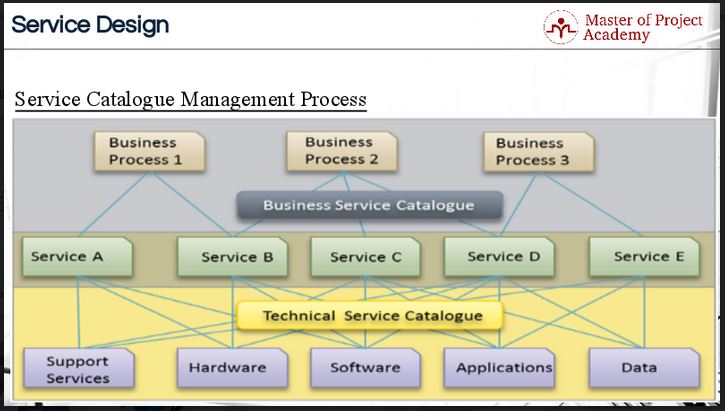Let’s review what the service catalog is in the world of ITIL training. The service catalog is part of the service portfolio and includes only live services or services which are available for deployment in a service provider organization. It is kept up to date by the service catalog manager as defined in the roles and responsibilities of an IT service organization as stipulated in online ITIL courses. The service catalog management process has certain goals, objectives and process activities that must be kept in mind. There are also two types of service catalogs that
The service catalog management process has certain goals, objectives and process activities that must be kept in mind. There are also two types of service catalogs that interact: the technical catalog and the business catalog. All of these will form part of the cogs that is necessary to manage IT services in an IT service organization.
What are the goals of the service catalog management process?
The main purpose of service catalog management is ensuring that a catalog of services is produced and maintained. The catalog is the viewable part of the service portfolio for the customers and support personnel. New services are planned, designed, tested, implemented and deployed in an organization. Also, old services are retired. Therefore there is always an update to the catalog part of the service portfolio since live and services which are waiting for deployment change during time. To have the most accurate information about the services, the catalog needs to be kept up to date and this is done mainly by the service catalog management process.
The service catalog management process aims to contain accurate information on all operational services and those services being prepared to be run operationally. Without accurate information, the company may make decisions based on out-of-date information which can lead to disastrous results.
What are the objectives of the service catalog management process?
The ultimate objective of the service catalog management is managing the information contained in the catalog. The catalog includes detailed information about live services and services which are waiting for deployment. And the main objective of the service catalog management process is the management of this data.
Ensuring that the information in the catalog is current is another objective. The catalog is the viewable part of the service portfolio to the customers and support teams. Accurate and up-to-date information in the catalog is crucial. It is important that everyone in the IT services team have access to up-to-date information regarding existing services and services ready for deployment. This will help to make accurate decisions during the various steps of the ITIL lifecycle.
The service catalog management process also aims to reflect details, status, interfaces and, dependencies of all services. The catalog includes details of all operational services. These details include, for instance, input parameters and expected output. It also reflects the current status of the service, for example, the service could be live, idle or waiting for deployment. Other details include interfaces from which points these services can be reached, and also dependencies of the services. For example, a customer balance inquiry service depends on customer account inquiry service in order to operate successfully. These kinds of details about all operational services need to be stored, managed and updated in the service catalog and this is mainly under the control of service catalog management process.
Two types of service catalogs
There are two types of service catalogs in a service provider organization.
- Technical catalog
- Business catalog.
This figure depicts the relationship of the business service catalog with the technical service catalog. As you see in the figure, the technical catalog reflects the interrelationships of services with support services, hardware, software, applications, and data. And the business catalog reflects the interrelationships of the services with the business services. The common part of technical and business catalogs is that they both contain information about the services of a service provider but the information they contain differ.

For instance, let’s consider that money withdrawal is a service of a bank provided through its ATM channels. Business process interrelated to this service can be Money Withdrawal through ATM and technical interrelationships of this service can be ATM machine as hardware dependency and the ATM software. These interrelationships must be managed by the service catalog manager.
What are the process activities for Service Catalog Management?
The first activity is arranging and documenting the service definition with all relevant parties. The catalog includes detailed information, status, interfaces, and dependencies of all operational services. Gathering all these information about the services, storing it in the catalog and keeping the catalog up to date is under the responsibility of the service catalog manager and the service catalog management process.

The second activity is the collaboration with the service portfolio manager in order to agree on the contents of the service portfolio and the catalog. The catalog is part of the service portfolio which includes live services and services waiting for deployment. The service portfolio also includes information about services that are still in the design phase as well as retired services. There is an overlap in the tasks of the service portfolio manager and the service catalog manager and therefore, the service catalog management process needs to collaborate with the service portfolio management process while constructing the service portfolio.
The third and the last activity is the creation and upkeep of a catalog with its contents in combination with the service portfolio. The service catalog management process both creates the catalog with the relevant information and also keeps the catalog up to date. There will be new services or changes to existing services. These updates to the services will require changes to the catalog documentation and therefore in service portfolio as well. The service catalog management process aims to update information about the services and to have the latest information about all operational services.
Management of the catalog of services in an IT organization is a crucial job to keep the ITIL service lifecycle going as briefly seen in the free ITIL course. As services go through the ITIL service lifecycle they are added, updated and removed from the catalog. The catalog is a live document that the service catalog manager must review and update regularly.

